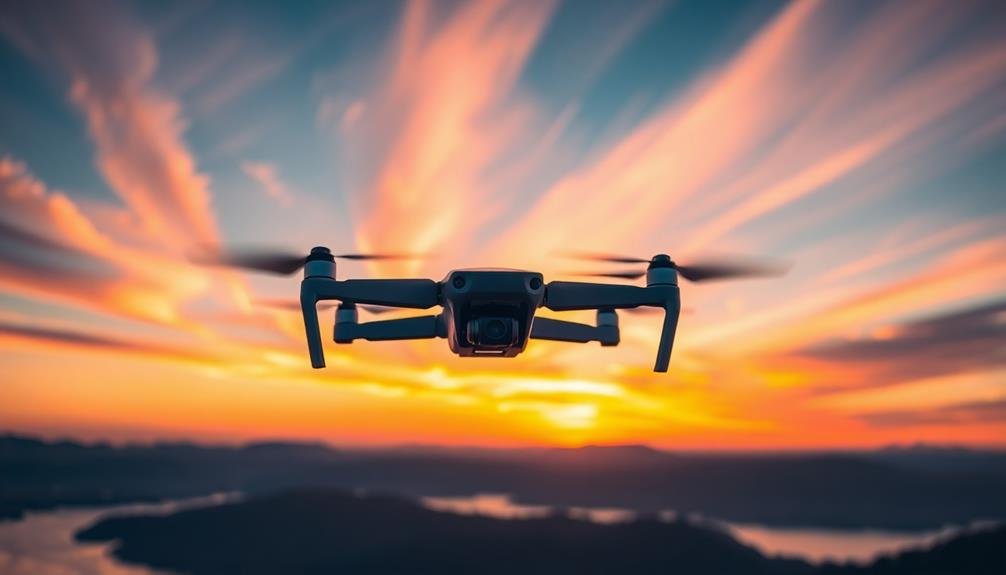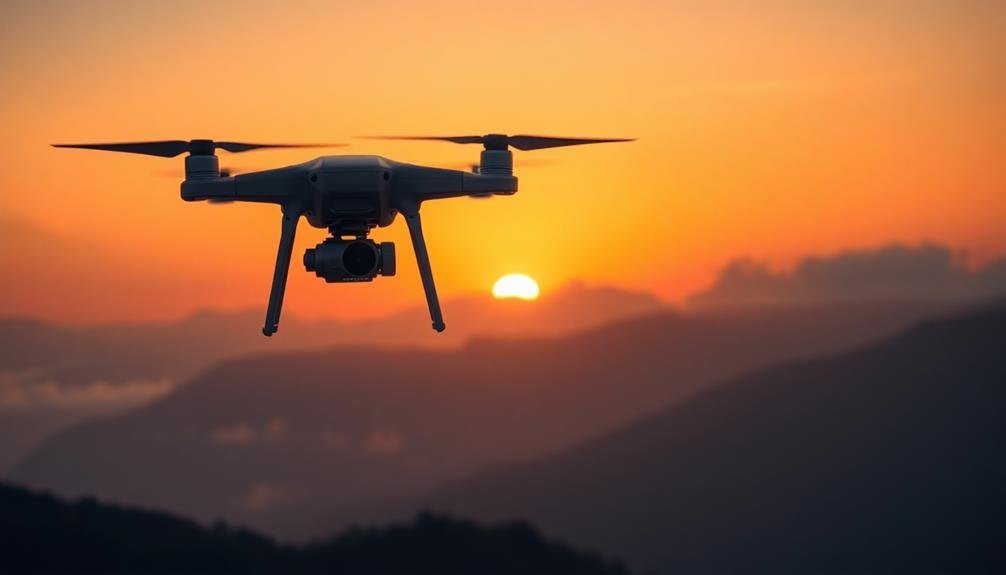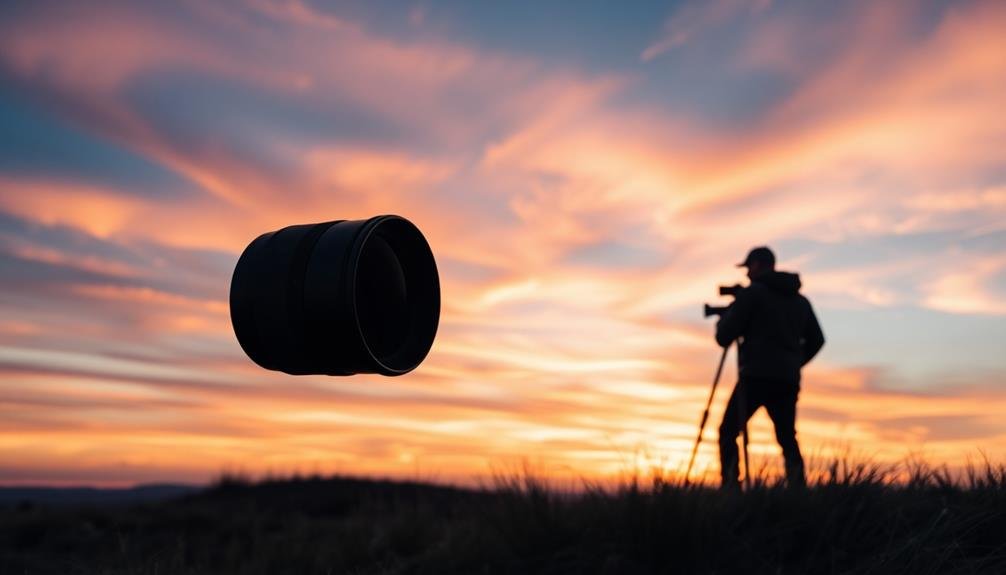For sky-high photography success, consider these top ND filters: PolarPro Cinema Series, Moment Variable ND, and NiSi Drone Filter Kit. PolarPro offers various strengths for DJI drones, guaranteeing peak light reduction. Moment's variable filters allow on-the-fly adjustments, perfect for changing conditions. NiSi's kit includes both ND and polarizing options, enhancing colors and versatility. When choosing, look for high-grade optical glass with multi-coating to maintain image quality. Confirm the filter fits your drone's lens diameter and check for color neutrality to avoid unwanted shifts. With the right ND filter, you'll reveal stunning aerial shots and creative possibilities. Dive deeper to master the art of drone photography with filters.
Key Takeaways
- PolarPro Cinema Series ND filters are highly recommended for DJI drones, offering various strengths for optimal sky photography.
- Moment Variable ND Filters provide on-the-fly adjustments, ideal for changing light conditions during aerial shoots.
- NiSi Drone Filter Kit combines ND and polarizing options, enhancing colors and contrast in sky photography.
- Quality ND filters use high-grade optical glass with multi-coating to minimize image degradation and color shifts.
- When selecting ND filters, consider strength (measured in stops), filter neutrality, and compatibility with your drone's lens diameter.
Choosing the Right ND Filter

Precision is key when selecting the right ND filter for your photography needs. You'll want to take into account the strength of the filter, which is measured in stops. A 3-stop filter reduces light by 8 times, while a 10-stop filter reduces it by 1,000 times. Choose based on your shooting conditions and desired effect.
Next, take into account the filter's quality. Look for filters made from high-grade optical glass with multi-coating to minimize reflections and color casts. Avoid cheap plastic filters that can degrade image quality.
Size matters too. Verify the filter fits your lens diameter or invest in a square filter system for versatility across different lenses. If you're using wide-angle lenses, be wary of vignetting with screw-on filters.
Don't forget about filter neutrality. Some ND filters can introduce color shifts, particularly in long exposures. Research brands known for color neutrality to maintain accurate colors in your images.
Lastly, take into account your shooting style. If you frequently shoot in varying light conditions, a variable ND filter might be more convenient. However, fixed ND filters often provide better image quality and are more reliable for consistent results.
Top ND Filters for Drones

When it comes to drone photography, ND filters are essential for capturing stunning aerial shots. They help you control exposure and achieve smooth, cinematic footage even in bright conditions.
For DJI drones, the PolarPro Cinema Series ND filters are of the highest quality. They offer excellent image clarity and come in various strengths, from ND4 to ND32.
If you're looking for versatility, consider the Moment Variable ND Filters for drones. These allow you to adjust the filter strength on the fly, giving you more control over your shots without switching filters.
For budget-conscious drone pilots, the Freewell Standard Day Filter Set provides good value without compromising quality.
Don't forget about polarizing ND filters, which can enhance colors and reduce glare. The NiSi Drone Filter Kit for DJI Mavic series includes both ND and polarizing options.
For professional-grade results, invest in the Tiffen Neutral Density Filter Kit, known for its color accuracy and durability.
Remember to choose filters specifically designed for your drone model to guarantee proper fit and performance.
With the right ND filter, you'll elevate your aerial photography and capture breathtaking scenes from above.
Using ND Filters Effectively

Now that you've selected the right ND filter for your needs, it's time to master their use. Start by attaching the filter securely to your lens, ensuring it's clean and free from fingerprints or smudges.
Adjust your camera settings to compensate for the reduced light: increase your exposure time or widen your aperture. For long exposures, use a tripod to maintain sharpness and prevent camera shake.
When shooting landscapes, ND filters help create smooth, silky water effects or capture cloud movement. For portraits, they allow you to use wider apertures in bright conditions, achieving a shallow depth of field.
In urban settings, ND filters can remove people from busy scenes by extending exposure times.
Remember to focus before attaching the filter, as some darker filters can interfere with autofocus. Use your camera's live view or an external light meter to fine-tune exposure.
Experiment with different strengths of ND filters to achieve various creative effects. Don't forget to remove the filter when shooting in low light conditions.
With practice, you'll learn to leverage ND filters to enhance your photography, capturing stunning images that stand out from the crowd.
Frequently Asked Questions
Can ND Filters Affect the Color Balance of Drone Photos?
Yes, ND filters can affect the color balance of your drone photos. They may introduce a slight color cast, typically warm or cool tones. You'll need to adjust your white balance or post-process to correct any unwanted color shifts.
Are There Special Considerations for Using ND Filters in Extreme Temperatures?
When using ND filters in extreme temperatures, you'll need to be cautious. Cold can cause condensation, while heat may warp filters. Always acclimate your gear and use protective cases. Consider temperature-resistant filter materials for harsh conditions.
How Do ND Filters Impact Battery Life When Used on Drones?
ND filters don't directly impact your drone's battery life. However, they require longer exposure times, which means you'll keep your drone airborne longer for each shot. This increased flight time can drain your battery faster.
Can ND Filters Interfere With Obstacle Avoidance Sensors on Drones?
Yes, ND filters can potentially interfere with obstacle avoidance sensors on your drone. They may reduce light transmission, affecting the sensors' ability to detect obstacles accurately. It's essential to test your drone's performance with filters before flying.
Are There Any Legal Restrictions on Using ND Filters for Aerial Photography?
There aren't specific legal restrictions on using ND filters for aerial photography. However, you'll need to follow general drone regulations in your area. Always check local laws and obtain necessary permits before flying your drone.
In Summary
You've now got the knowledge to elevate your drone photography with ND filters. Remember, choosing the right filter, understanding top options, and mastering effective usage are key. Don't be afraid to experiment with different densities and techniques. As you practice, you'll see a dramatic improvement in your aerial shots. Keep pushing your creative boundaries, and soon you'll be capturing breathtaking sky-high images that truly stand out. Happy flying and shooting!

As educators and advocates for responsible drone use, we’re committed to sharing our knowledge and expertise with aspiring aerial photographers.




Leave a Reply